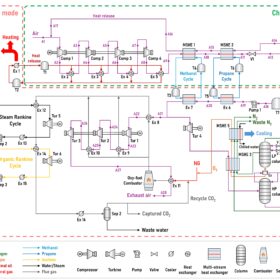China reviewing anti-dumping duties on solar-grade silicon from US, South Korea
The Chinese government says it will review 2014 anti-dumping duties on US and South Korean polysilicon imports, and will maintain them during its investigation, which was requested by 13 Chinese manufacturers.
Korean scientists build PV-powered supercapacitor with 35.5 Wh/kg energy density
Scientists in Korea have fabricated a solar-powered charging device that can reportedly achieve a power density of 2,555.6 W kg and an energy efficiency of 63%. The system uses nickel-based compounds to enhance the electrochemical performance of its electrodes.
The best hole transport layers for perovskite solar cells
An international team has combined organic synthesis with predictive models to discover new functional materials that enhance performance of hole transport layers used in perovskite solar cells. The team asserts that optimizing for other solar cell properties is possible with the platform, as well as using it for development of materials for other kinds of devices.
Samsung launches monobloc air-to-water heat pumps
The Korean manufacturer said its new products are now available in the North American market and are suitable for multi-unit homes, apartments, new-builds and retrofits. The systems work with new AI technology and reportedly perform better when connected to a PV system.
Qcells hits 28.6% efficiency with scalable perovskite-silicon solar cell
South Korea-based solar module manufacturer Qcells has set a new efficiency world record for a commercially scalable perovskite-silicon tandem solar cell, produced at its pilot line in Germany.
The Hydrogen Stream: new model and repository for accurate pre-feasibility studies
European researchers have told pv magazine that hydrogen production costs are often underestimated in prefeasibility studies, while the South Korean authorities have reported a rise in deals for large-scale hydrogen consumption projects.
Standalone liquid air energy storage system for power, heating, cooling supply
Korean scientists have designed a liquid air energy storage (LAES) technology that reportedly overcomes the major limitation of LAES systems – their relatively low round-trip efficiency. The novel system enhances efficiency by increasing power output through the generation of thermal energy using natural gas as the external fuel during energy release.
KRICT sets world record with 20.6% efficiency for large-area perovskite cells
The Korea Research Institute of Chemical Technology (KRICT) has set a world record for power conversion efficiency at 20.6% for large-area perovskite solar cells exceeding 200 cm². The result, confirmed by Germany’s Fraunhofer Institute for Solar Energy Systems ISE (Fraunhofer ISE), marks a significant milestone in solar cell technology.
Hybrid perovskite-organic solar cell reaches record-breaking efficiency of 24%
Korean scientists have fabricated a perovskite-organic solar cell with a uniform sub-nanometer dipole layer. The device recorded a power conversion efficiency of 24% under testing, a new record for lead-based hybrid perovskite-organic solar cells.
Japanese scientists build stretchable organic solar cell with 14.2% efficiency
Researchers in Japan have built a stretchable organic solar cell than can ensure high efficiency levels while preventing crack initiation and propagation. The cell was built with a hole transport layer based on PEDOT:PSS treated with a new additive type.









